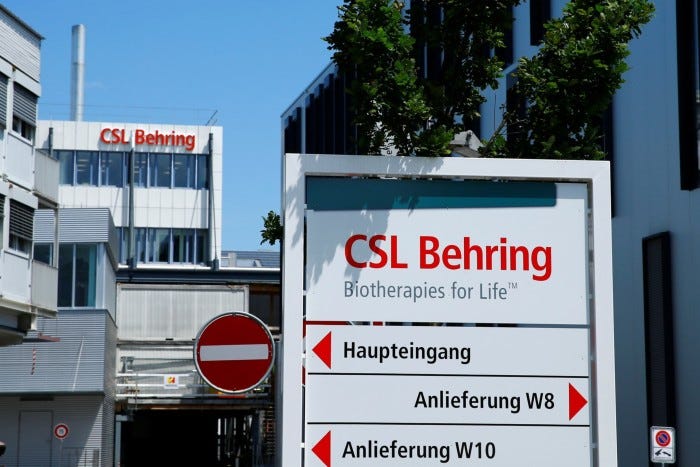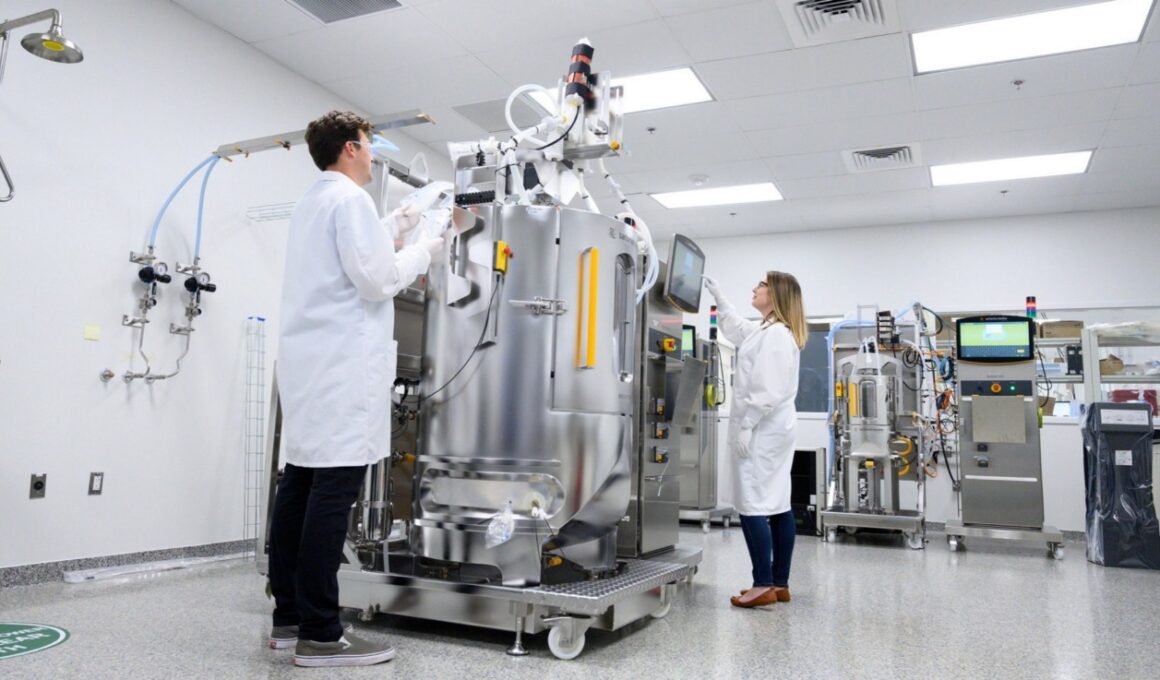Health Transformation Institute (HTI)
Joaquim Cardoso MSc
Founder and Chief Researcher, Editor and Advisor
December 15, 2022
Source:
Financial Times
December 15, 2022
Gene therapies may cure disease but can we afford them?
For most of his life Rob Schroeder had to regularly inject blood clotting factor to stop the uncontrolled bleeding caused by the genetic disorder haemophilia B.
But his life was transformed four year ago after he volunteered to become one of the first patients to trial an experimental gene therapy called Hemgenix.
“I haven’t had a bleed since I had the treatment. Nothing. I effectively reached my wildest dream goals with this therapy,” Schroeder, a pharmaceutical rep from Monclova, Ohio, told the Financial Times.

Last month the US Food and Drug Administration approved Hemgenix, which was developed by CSL Behring and UniQure and is delivered via a single dose though intravenous infusion.
It is the fifth gene therapy targeting rare diseases given the green light by US regulators since 2017, underlining the potential of this new class of medicines to treat and in some instances cure rare diseases, cancers and other conditions.
Gene therapies, which work by adding a new gene or repairing a mutated one inside the body, can dramatically improve health disorders by fixing their underlying cause, typically by administering a once-off treatment.
But they are complex medicines that can have dangerous side effects and are sold at extremely high prices.
But they are complex medicines that can have dangerous side effects and are sold at extremely high prices.
CSL’s Hemgenix costs $3.5mn per dose, which makes it the most expensive drug in the world.
Skysona and Zynteglo, which are gene therapies targeting a rare childhood brain disease and an inherited blood disorder, developed by the Cambridge, Massachusetts-based biotech Bluebird Bio, are the second- and third-most expensive drugs on the market. They are priced at $3mn and $2.8mn per dose, respectively.
Health experts warn the costs of gene therapies could limit the willingness of public and private insurers to cover them and make them unobtainable for many patients.
With more than a thousand gene and cell therapies in clinical trials there are concerns health systems could buckle under the strain of the short-term costs of meeting demand for the treatments.

Last year Bluebird Bio withdrew Zynteglo, a one-time gene therapy for the blood disorder beta thalassaemia, from the European market after failing to persuade governments to cover its $1.8mn price tag.
European payers had not evolved their approach to gene therapy in a way that valued innovation, the company told analysts.
It described elements of the European system as “frankly broken” and “untenable” for investment.
Bluebird was forced to slash costs by cutting 30 per cent of its staff following its European withdrawal and is now targeting sales in the US, where regulators approved Zynteglo in August.
Miguel Forte, president of the International Society of Cell & Gene Therapy, a group of clinicians, researchers and industry partners supporting development of these medicines, said the withdrawal of a proven therapy was disappointing and any repeat would be of “serious concern”.
“I think a discussion on affordability is essential because we need to ensure these innovative medicines are available to patients and we also need to continue to learn about them and develop new products.”
In contrast, Zolgensma, Novartis’s spinal muscular atrophy gene therapy that was the most expensive in the world when it debuted in 2019, sold well in its early years.
Sales rose by 36 per cent year on year in 2021, as the Swiss drugmaker expanded access to Europe and emerging markets.
But in the last quarter, sales fell by 15 per cent, which the company attributed to a slowdown while it added new markets.
Novartis said it did not think the decline in sales was linked to reports of deaths of two children who had taken the drug.
Gene therapy products may be costly, but they provide enormous benefits to patients and health systems, said Forte.
The once-off nature of such curative therapies improves the quality of life of sufferers of rare diseases and can save money over the long term by reducing or eliminating the need for medical treatment, he added.
“If we are not able to square the circle over costs and reimbursement, then we will fail to deliver the right opportunities to patients.”

The biopharma industry says high prices are necessary to cover the development costs of gene therapies, which at $5bn is roughly five times that of traditional drugs.
The markets for these drugs are also typically small, and complex manufacturing and regulatory processes usually lead to long lead times before treatments become available.
Investors and companies ploughed a record $22.7bn into cell, gene and tissue-engineered therapies last year, compared to $19.9bn a year earlier, according to the Alliance for Regenerative Medicine, a lobby group representing large and small companies in the sector.
For now, sales of gene and cell therapies are relatively modest at about $4bn in 2021 but these are forecast to rise to $45bn by 2026, as dozens more therapies are approved, according to Evaluate Pharma, a market intelligence firm. But achieving this sales growth depends on the willingness of governments, insurers and other healthcare payers in rich countries to cover the cost of treatments.
“Our health system cannot afford to pay whatever price drug corporations demand for these new drugs — no matter how revolutionary,” said Merith Basey, executive director of Patients For Affordable Drugs Now, an advocacy group.
“Our health system cannot afford to pay whatever price drug corporations demand for these new drugs — no matter how revolutionary,”
“Hemgenix represents life-changing innovation for patients who can afford it, but that new innovation is worthless for those who can’t . . . At these prices, they will ultimately break the back of our ability to pay in both public and private insurance.”
Bob Lojewski, CSL’s senior vice-president and general manager North America, said the $3.5mn price tag on Hemgenix was justified because it was possibly “the most effective treatment in the world” and would generate big savings over the long term.
Some discounts would also be available to health insurers and payers, he added.
“It is kind of unfortunate that price steals the headline away from the safety and efficacy and promise of the therapy,” he said.
“To look at the lifetime treatment of a haemophilia B patient, you’re going to see costs upwards of $20mn for these patients in terms of their healthcare.”
“To look at the lifetime treatment of a haemophilia B patient, you’re going to see costs upwards of $20mn for these patients in terms of their healthcare.”
A review by the Institute for Clinical and Economic Review, an independent drug watchdog, concluded a price of up to $2.96mn was justified for Hemgenix because of its effectiveness.
It said successfully treated patients appeared “cured” for at least a period of time, although the institute warned there was still considerable uncertainty that the treatment’s success would prove to be durable over the long term.
AHIP, a group representing more than 1,300 companies that provide health insurance to 200mn Americans, said its members were not averse to paying for gene therapy drugs, as long as they proved to be effective and value for money.
AHIP, a group representing more than 1,300 companies that provide health insurance to 200mn Americans, said its members were not averse to paying for gene therapy drugs, as long as they proved to be effective and value for money.
Insurers would probably set restrictions to ensure only those who were most suitable for the treatments had access to them and co-payments from patients would be common, it added.
“In the case of the Hemgenix drug, it has got a lot going for it. It’s a cure. It’s one and done. It happens to be helping a population, people with haemophilia B, that doesn’t have a lot of options for treatment,” said Sergio Santiviago, vice-president of drug policy at AHIP.
Santiviago said insurers are exploring risk-based payment approaches to overcome the challenges of covering costly therapies that in most cases have not proven their durability over longer timeframes.
For example, members have agreed a coverage deal for Zynteglo, which provides for Bluebird Bio to pay 80 per cent refunds if patients continue to require blood transfusions within two years of treatment, he said.
…insurers are exploring risk-based payment approaches to overcome the challenges of covering costly therapies that in most cases have not proven their durability over longer timeframes.
But Santiviago said the economics of covering gene therapies becomes more difficult when large numbers of patients could become eligible for multimillion-dollar treatments, particularly if there was not strong evidence supporting its effectiveness.

An important test is on the horizon with the anticipated approval next year in the US of a gene therapy targeting sickle cell disease, which has been developed by Vertex Pharmaceuticals and Crispr Therapeutics.
About 100,000 Americans live with sickle cell disease in the US, compared to only around 30,000 people with haemophilia B.
A study assessing the impact of gene therapies on state budgets in the US, which was published last year in the journal Jama Pediatrics, concluded that a successful gene therapy for sickle cell disease would present affordability problems for several Medicaid insurance plans.
A study assessing the impact of gene therapies on state budgets in the US, which was published last year in the journal Jama Pediatrics, concluded that a successful gene therapy for sickle cell disease would present affordability problems for several Medicaid insurance plans.
“While therapies with huge price tags garner a lot of attention, what tends to be more consequential from a payers’ perspective is the patient population size,” said Patrick DeMartino, a physician specialising in care for children with blood disorders and co-author of the Jama study.
“From a patient access and advocacy perspective, if there were delays in access from a payer constrained side, that would be a PR nightmare.
I think it would harm people but it would also be very bad optics for the payer.”
Originally published at https://www.ft.com on December 15, 2022.
Names mentioned
Food and Drug Administration
Hemgenix,
CSL Behring and UniQure
Merith Basey, executive director of Patients For Affordable Drugs Now, an advocacy group.
Bob Lojewski, CSL’s senior vice-president and general manager North America,
Vertex Pharmaceuticals and Crispr Therapeutics
Patrick DeMartino, a physician specialising in care for children with blood disorders and co-author




